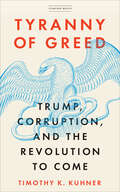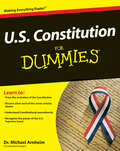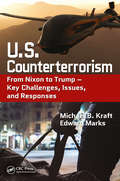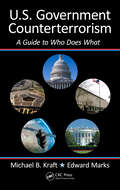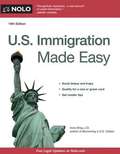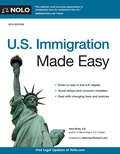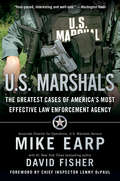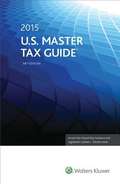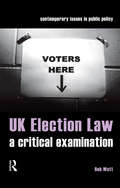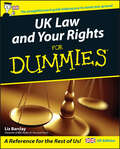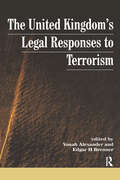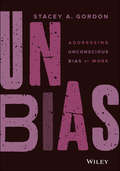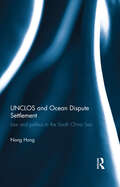- Table View
- List View
Tyranny of Greed: Trump, Corruption, and the Revolution to Come (Stanford Briefs)
by Timothy K. KuhnerDemocracy is being destroyed by an ancient evil, and modernity is in denial. In the Tyranny of Greed, Timothy K. Kuhner reveals the United States to be a government by and for the wealthy, with Trump—the spirit of infinite greed—at its helm. Taking readers on a tour through evolutionary biology, psychology, and biblical sources, Kuhner explores how democracy emerged from religious and revolutionary awakenings. He argues that to overcome Trump's regime and establish real democracy, we must reconnect with that radical heritage. Our political tradition demands a revolution against corruption.
Tyrants on Twitter: Protecting Democracies from Information Warfare (Stanford Studies in Law and Politics)
by David L. SlossA look inside the weaponization of social media, and an innovative proposal for protecting Western democracies from information warfare. When Facebook, Twitter, YouTube, and Instagram were first introduced to the public, their mission was simple: they were designed to help people become more connected to each other. Social media became a thriving digital space by giving its users the freedom to share whatever they wanted with their friends and followers. Unfortunately, these same digital tools are also easy to manipulate. As exemplified by Russia's interference in the 2016 U.S. presidential election, authoritarian states can exploit social media to interfere with democratic governance in open societies. Tyrants on Twitter is the first detailed analysis of how Chinese and Russian agents weaponize Facebook, Instagram, Twitter, and YouTube to subvert the liberal international order. In addition to examining the 2016 U.S. election, David L. Sloss explores Russia's use of foreign influence operations to threaten democracies in Europe, as well as China's use of social media and other digital tools to meddle in Western democracies and buttress autocratic rulers around the world. Sloss calls for cooperation among democratic governments to create a new transnational system for regulating social media to protect Western democracies from information warfare. Drawing on his professional experience as an arms control negotiator, he outlines a novel system of transnational governance that Western democracies can enforce by harmonizing their domestic regulations. And drawing on his academic expertise in constitutional law, he explains why that system—if implemented by legislation in the United States—would be constitutionally defensible, despite likely First Amendment objections. With its critical examination of information warfare and its proposal for practical legislative solutions to fight back, this book is essential reading in a time when disinformation campaigns threaten to undermine democracy.
U. S. Immigration Made Easy (11th edition)
by Laurence A. Canter Martha S. Siegel Nona BrayWritten by two immigration attorneys who have obtained visas and green cards for thousands of foreign nationals, this bestselling book - now completely revised and updated - covers every possible way to legally enter and live in the United States. Readers find out how the U.S. immigration system really works, and how to qualify for: student visas, work visas, asylum, green cards, and citizenship. U.S. Immigration Made Easy provides all the necessary form and the step-by-step instructions needed to fill them out. Hopeful immigrants will learn how to fill out and file all the required paperwork, and get the inside scoop on how to approach the enormous INS bureaucracy.
U.S. Constitution For Dummies: 2nd Edition
by Michael ArnheimAn in-depth look at the defining document of America Want to make sense of the U.S. Constitution? This plain-English guide walks you through this revered document, explaining how the articles and amendments came to be and how they have guided legislators, judges, and presidents and sparked ongoing debates. You'll understand all the big issues — from separation of church and state to impeachment to civil rights — that continue to affect Americans' daily lives. Get started with Constitution basics — explore the main concepts and their origins, the different approaches to interpretation, and how the document has changed over the past 200+ years Know who has the power — see how the public, the President, Congress, and the Supreme Court share in the ruling of America Balance the branches of government — discover what it means to be Commander in Chief, the functions of the House and Senate, and how Supreme Court justices are appointed Break down the Bill of Rights — from freedom of religion to the prohibition of "cruel and unusual punishments," understand what the first ten amendments mean Make sense of the modifications — see how amendments have reformed presidential elections, abolished slavery, given voting rights to women, and more Open the book and find: The text of the Constitution and its ammendments Discussion of controversial issues including the death penalty, abortion, and gay marriage Why the word "democracy" doesn't appear in the Constitution What the Electoral College is and how it elects a President Details on recent Supreme Court decisions The Founding Fathers' intentions for balancing power in Washington
U.S. Counterterrorism: From Nixon to Trump – Key Challenges, Issues, and Responses
by Michael B. Kraft Edward Marks"Writing with years of experience in government, Ambassador Edward Marks and Michael Kraft have produced a splendid history of America’s long campaign against terrorism. The book analyzes the recent changes in technology and tactics that have profoundly altered today’s terrorist challenge…to understand where we are and how we got there, start here."—Brian Michael Jenkins, The Rand Corporation "…This book provides important perspective on where the United States has been in this fight and how that fight must evolve in the new administration. It is must reading for the Trump Administration and anyone else seriously concerned about the next steps in this long struggle." —Brig. Gen. Francis X Taylor, USAF (Rtd.), Former U.S. Coordinator for Counterterrorism and DHS Under Secretary for Intelligence and Analysis "…an indispensable guide to U.S. counterterrorism efforts and policies spanning five decades and nine presidencies … (The book) fills a significant gap in the literature by providing an invaluable historical context to this unending struggle." —Professor Bruce Hoffman, Director, Security Studies, Georgetown University "A clear and comprehensive survey of American policy toward terrorism over the past half century … it provides essential background for analysis of future policy." —Martha Crenshaw, Center for International Security and Cooperation, Stanford University U.S. Counterterrorism: From Nixon to Trump - Key Challenges, Issues, and Responses examines the "war on modern terrorism," from the Nixon administration to the early stages of the Trump administration. The book describes the evolution of U.S. counterterrorism responses to the changing terrorist threats, from primarily secular groups, to those with broad-reaching fundamentalist religious goals such as ISIS. The authors highlight the accelerating rate of changes in the terrorism situation from modern technology; the internet, "lone wolf" terrorists, cyber threats, and armed drones. The book describes the Bush Administration’s dealing with terrorism as an existential threat and a Global War on Terrorism following 9/11. It then discusses how the Obama administration both continued and modified previous policies. The book provides an extensive list of key documents for those interested in the original texts and a discussion of legal issues. U.S. Counterterrorism provides insights and a useful backdrop for future decisions by the new administration and Congress.
U.S. Government Counterterrorism: A Guide to Who Does What
by Michael Kraft Edward MarksU.S. Government Counterterrorism: A Guide to Who Does What is the first readily available, unclassified guide to the many U.S. government agencies, bureau offices, and programs involved in all aspects of countering terrorism domestically and overseas. The authors, veterans of the U.S. government‘s counterterrorism efforts, present a rare insider‘s
U.S. Immigration Made Easy
by Ilona BrayReady to move to the USA? Here's the insider's guide you need! U.S. Immigration Made Easy covers every possible way to legally enter and live in the United States. Learn how the immigration system really works and find out whether you qualify for: . work visas . student visas . refugee status . green cards . citizenship . and more Get tips on dealing with paperwork, government officials, delays and denials. Plus, you'll get step-by-step instructions on filling out and filing forms, and learn the best way to approach the enormous U.S. Citizenship and Immigration Services (USCIS) bureaucracy. Thoroughly updated and revised, this edition has been updated and revised to cover the latest changes in immigration law, including new addresses for sending various immigration petitions, average processing times, how a spouse living overseas can prove ability to support immigrants in the U.S., how to find forms and case status information on the USCIS website, and much more.
U.S. Immigration Made Easy
by Ilona BrayWant to live, work, or travel in the United States? U.S. Immigration Made Easy has helped tens of thousands of people get a visa, green card, or other immigration status. You’ll learn: whether you and your family qualify for a short-term visa, permanent U.S. residence, or protection from deportation how to obtain, fill out, and submit the necessary forms and documents insider tips on dealing with bureaucratic officials, delays, and denials strategies for overcoming low income and other immigration barriers, and how to select the right attorney. U.S. Immigration Made Easy provides detailed descriptions of application processes and helps you avoid traps that might destroy your chances. There’s also an immigration eligibility self-quiz, which helps you match your background and skills to a likely category of visa or green card. The 19th edition is completely updated to cover recent legal and fee changes including Trump administration efforts to end TPS for various countries and end DACA. NOTE: Does not cover naturalization.
U.S. Immigration Made Easy
by Ilona Bray J.D.What U.S. law says about who is eligible to immigrate, whether on a permanent or temporary basis, can be hard to interpret, and even harder to act upon. U.S. Immigration Made Easy, however, demystifies the system, discussing almost every possible way to legally enter, live in, or stay in the United States. Learn how the immigration system really works and find out whether you qualify for: a work visa a student visa asylum or refugee status a green card through family, employment, or in some other category Deferred Action for Childhood Arrivals (DACA) and more Get tips on dealing with paperwork, government officials, delays and denials. Plus, you'll get step-by-step instructions on filling out and filing forms, and learn the best way to approach the enormous U.S. government bureaucracy. Thoroughly updated and revised, this edition covers the latest changes in immigration law, including new opportunities for same-sex couples, the new "provisional waiver of unlawful presence" (offering a new path to a green card to family members of U.S. citizens, the latest average processing times, and much more. It also discusses important changes made by President Obama's Executive Order of November 20, 2014.
U.S. Immigration Made Easy
by Ilona Bray J.D. Richard LinkMany people have misconceptions about the complex tangle that is U.S. immigration law. Even a prospective immigrant with simple questions about who is eligible to come to the U.S. on a permanent or temporary basis will find the rules hard to interpret, and even harder to act upon. U.S. Immigration Made Easy demystifies the system, discussing almost every possible way to legally enter, live in, or stay in the United States. Learn how the immigration system really works and find out whether you qualify for: a work visa a student visa asylum or refugee status a green card through family, employment, or in some other category Deferred Action for Childhood Arrivals (DACA) a U visa, and more. Get tips on dealing with paperwork, government officials, delays and denials. Plus, you'll get step-by-step instructions on filling out and filing application forms, and learn the best way to approach the enormous U.S. government bureaucracy. Thoroughly updated and revised, this edition covers the latest changes in immigration law, including expansion of the new “provisional waiver of unlawful presence” to family members of lawful permanent residents living in the U.S.), the latest average processing times, and much more.
U.S. International Economic Strategy in a Turbulent World: Strategic Rethink
by Howard J. ShatzThis report presents strategic choices America faces regarding the international economy over the term of the next U.S. administration, focusing on policy choices in the areas of maintaining and improving the rules-based international economic system; working with China and better integrating it into the existing system; supporting economic growth of allies and partners; and using sanctions to change unwanted behavior and counter adversaries.
U.S. Marshals: Inside America's Most Storied Law Enforcement Agency
by David Fisher Mike EarpDeputy U.S. Marshal: How often did you draw your gun?Retiring FBI Agent: Never. You?Deputy U.S. Marshal: Seven times before lunch.123,006 FugitivesThat's how many wanted men and women, each with an average of four felony convictions to his or her name, the U.S. Marshals Service tracked down and arrested in 2012. Of that number, 3,962 were charged with murder, most were violent career criminals, and all were on the run from the authorities. If you are a fugitive in America, your worst nightmare is a deputy U.S. marshal on your trail: each year the Marshals Service takes more criminals off the streets than every other federal law enforcement agency—combined.From Mike Earp, the former associate director of operations for the Marshals Service, and New York Times bestselling author David Fisher, this book tells the thrilling inside story of today's U.S. marshals in their own words. Based on interviews with more than fifty current and former deputies, as well as Earp's personal case notes, here are the greatest cases, hairiest arrests, and most unforgettable moments, all revealed for the first time. Here also is a history of how the marshals of legend have evolved into the country's frontline law enforcement agency, charged with apprehending the most notorious and dangerous suspects. The U.S. Marshals Service is America's oldest law enforcement agency, established in 1789 by George Washington, who called for "the selection of the fittest characters to expound the law and dispense justice." It has had a long and colorful history, famously interwoven into the mythology of the Wild West, with notable real-life marshals like Wyatt Earp and Bass Reeves and legendary fictional characters like Matt Dillon, Elmore Leonard's Raylan Givens, and Rooster Cogburn, played by John Wayne in the 1969 film True Grit.However, what few people realize is that in the past three decades the marshals have been at the heart of a transformation of the entire structure of law enforcement in America. The Marshals Service has become the most effective U.S. law enforcement agency, responsible for tracking down the nation's most wanted fugitives. Organized under the Department of Justice, the marshals serve as the apprehension arm for most federal agencies, including the FBI and the DEA, and across the nation U.S. Marshals regional task forces aid state and local law enforcement authorities to catch the most dangerous fugitives. All told, the Marshals Service processes more than 150,000 warrants each year, and deputies make an average of 337 arrests per day. They are also charged with transporting federal prisoners, protecting judges, and operating the Witness Security Program.This is the untold story of the new U.S. Marshals Service, as seen through the eyes of the men and women who were pivotal in solving many of the most high-profile and dangerous cases in recent history.
U.S. Master Tax Guide (2015), 98th Edition
by Wolters Kluwer CCH Editorial Staff PublicationThis edition provides helpful and practical guidance on today's federal tax law and reflects all pertinent federal taxation changes that affect 2014 returns and provides fast and reliable answers to tax questions affecting individuals and business income tax.
U.S. Supreme Court Opinions And Their Audiences
by Ryan C. Black Ryan J. Owens Justin Wedeking Patrick C. WohlfarthThis book is the first study specifically to investigate the extent to which US Supreme Court justices alter the clarity of their opinions based on expected reactions from their audiences.<P><P> The authors examine this dynamic by creating a unique measure of opinion clarity and then testing whether the Court writes clearer opinions when it faces ideologically hostile and ideologically scattered lower federal courts; when it decides cases involving poorly performing federal agencies; when it decides cases involving states with less professionalized legislatures and governors; and when it rules against public opinion. The data shows the Court writes clearer opinions in every one of these contexts, and demonstrates that actors are more likely to comply with clearer Court opinions.
UK Election Law: A Critical Examination (Contemporary Issues In Public Policy Ser.)
by Bob WattThis book contains a critical analysis of the law and politics governing the conduct of statutory elections in the United Kingdom. The author argues that elections have now become a marketplace for 'buying' the most seemingly attractive political party on offer into power, rather than an expression of democratic self-government. Thematically arranged, he considers a number of issues dating from before the Civil War through nineteenth century reforms to the foundation of the Electoral Commission and up to their paper 'Securing the Vote' published in 2005. The book Framing the debate for the Electoral Administration Bill 2005, it contains, amongst other legal analysis, analyses leading cases, including:Sanders v ChichesterR v JonesR v Whicher; ex parte MainwaringIn re Fermanagh and South Tyrone. The author presents an argument for a radical reappraisal of election law which involves, rather than excludes the self-governing citizenry, suggesting that election law, perhaps above all other kinds of law, should be the subject of vigorous and open public debate.
UK Law and Your Rights For Dummies
by Liz BarclayDo you know your legal rights and responsibilities if you're buying or selling a home, moving in with your partner, returning goods, getting your personal finances in order or dealing with a problematic neighbour? There are a multitude of legal rights to protect individuals, and most of us don't consider them until faced with an immediate legal problem. Boost your legal know-how with this simple guide that does away with the jargon and complication of the law, and helps you get a handle on a wide range of everyday legal issues. UK Law and Your Rights For Dummies shows you how to cut through the reams of red tape, avoid legal pitfalls and prepare yourself to deal with any situation.
UK's Legal Responses to Terrorism
by Yonah Alexander Edgar H BrennerFirst published in 2003. Routledge is an imprint of Taylor & Francis, an informa company.
UK, EU and Global Administrative Law
by Paul CraigPaul Craig's analysis of UK, EU and global administrative law examines the challenges facing each system and reveals the commonalities in and differences between their foundational assumptions. The challenges which they face may be particular to that legal order, endemic to any legal system of administrative law or the result of interaction between the three systems. The inter-relationship between the three levels is important. The legal and practical reality is that developments at one level can have an impact on the other two. Legal doctrine fashioned at the national level may therefore inform developments in EU and global administrative law. The doctrine thus created may then function symbiotically, shaping developments within a domestic legal order. The inter-relationship is equally marked from the regulatory perspective, since many such provisions originate at the global or EU level.
UN Interventions and Democratization: Case Studies of States in Political Transition (Societies and Political Orders in Transition)
by Carina Barbosa Gouvêa Pedro H. Castelo BrancoThis book analyzes United Nations (UN) interventions in the process of constitution making in states undergoing political change. It combines theoretical considerations of democracy and constitutionalism with empirical experiences and takes a critical perspective on the interventions developed by the United Nations in the processes of re-democratization. Presenting new empirical evidence on the substantive and procedural way in which the UN undertakes constitution building in Cambodia, Bosnia and Herzegovina, Afghanistan, and East Timor, the book illustrates difficulties of these practices such as the promotion of popular participation, as well as an increasing Westernization, and to meet local needs. In consequence, the authors call for reforms of the actions and structural methods the UN to better align a legitimate constitutional order with the rule of law and democratic values. This book is aimed at scholars and students of politics and law who are interested in the prerequisites and conditions for further democratization in states undergoing political transformation.
UN Peacekeeping Operations and the Protection of Civilians: Saving Succeeding Generations
by Conor FoleyOver 100,000 United Nations uniformed peacekeeping personnel are deployed on missions with authority from the Security Council to protect civilians in conflict zones. Chapter VII of the UN Charter allows for the use of force on UN missions, but does not list the rules governing the use; they are found in either the jus in bello provisions of international humanitarian law (IHL) or the regulations on the use of force in international human rights law. The UN Charter specifies that its provisions take precedence over all other international treaties. While the UN acknowledges the relevance of IHL to its missions, this book argues that the regulations of international human rights law usually provide more appropriate guidance. UN missions mandated to protect civilians have repeatedly failed to do so, and mechanisms need to be created to improve their accountability to those that they are responsible for protecting.
UN Territorial Administration and Human Rights: The Mission in Kosovo (Post-Conflict Law and Justice)
by Gjylbehare Bella MuratiThis book offers an original and insightful analysis of the human rights inadequacies that arise in the practice of UN territorial administration by analysing and assessing the practice of UNMIK. It provides arguments based on law and principles to support the thesis that a comprehensive legal framework governing the activities of the UN mission is a crucial prerequisite for its proper functioning. This is complemented by a discussion of several emerging issues surrounding the UN activity on the ground, namely, its legislative, judicial, and executive power. The author offers an extensive and well-documented analysis of the UN’s capacity as a surrogate state administration to respond to the needs of the governed population and, above all, protect its fundamental rights. Based on her findings, Murati concludes that only a comprehensive mandate can serve the long term interests of the international community’s objective to efficiently promote, protect, and fulfil human rights in a war-torn society. UN Territorial Administration and Human Rights provides a detailed critical legal analysis of one of the major UN administrations of territory after the Cold War, namely, the UN administration of Kosovo from 1999 to 2008. The analysis in this book will be beneficial to international law and international relations scholars and students, as well as policymakers and persons working for international organisations. The analysis and the lessons learned through this study shed light on the challenges entailed in governing territories and rebuilding state institutions while upholding the rule of law and ensuring respect for human rights.
UNBIAS: Addressing Unconscious Bias at Work
by Stacey A. GordonLet the CEO of Rework Work help you understand diversity, equity, and inclusion concepts to actively remove bias from the workplace Dismantling unhealthy workplaces involves much more than talking about it, and more than charts, graphs, and statistics—it requires action. Although it’s increasingly common for businesses of all shapes and sizes to appreciate the importance of diversity and inclusion in the workplace, many are often unaware of bias in the cultures they’ve created. Others might know there’s a problem, but don’t know how to properly address it. UNBIAS: Addressing Unconscious Bias At Work helps you understand concepts of workplace diversity, equity, and inclusion, shows you how to identify bias, and provides you with the tools for actively removing barriers and ensuring equity throughout your organization. Written by Stacey Gordon—CEO of Rework Work, a company on a mission to reduce bias in global talent acquisition and management—this real-world handbook offers step-by-step guidance on creating workplace cultures where employees feel they belong. UNBIAS teaches you to: Identify and address bias in the workplace Understand what you can do to be more inclusive Handle potentially uncomfortable conversations Discuss race in an authentic and meaningful way Use workplace-proven tools that make concepts of diversity and equity actionable Help your employee resource groups without giving them extra work Place accountability on organizational policies that allow biased behavior UNBIAS is a must-have resource for all employers, managers, and HR professionals seeking to create and sustain healthy, inclusive, and equitable workplace environments.
UNCITRAL Model Law on International Commercial Arbitration: A Commentary
by Ilias Bantekas Pietro Ortolani Shahla Ali Manuel A. Gomez Michael PolkinghorneThis book provides a comprehensive commentary on the UNCITRAL Model Law on International Arbitration. Combining both theory and practice, it is written by leading academics and practitioners from Europe, Asia and the Americas to ensure the book has a balanced international coverage. The book not only provides an article-by-article critical analysis, but also incorporates information on the reality of legal practice in UNCITRAL jurisdictions, ensuring it is more than a recitation of case law and variations in legal text. This is not a handbook for practitioners needing a supportive citation, but rather a guide for practitioners, legislators and academics to the reasons the Model Law was structured as it was, and the reasons variations have been adopted.
UNCLOS and Ocean Dispute Settlement: Law and Politics in the South China Sea
by Nong HongThe United Nations Convention on the Law of the Sea (UNCLOS) offers a legal framework for the sustainable development of the oceans and their natural resources. However, recently there have been calls to amend the Convention due to some ambiguous provisions which are unable to address a variety of contemporary maritime issues. This book evaluates the applicability and effectiveness of UNCLOS as a settlement mechanism for addressing ocean disputes. The book’s central focus is on the South China Sea (SCS) dispute, one of the most complex and challenging ocean-related conflicts in the world. The book examines the ways in which an emphasis on sovereignty, threats to maritime security and overlapping maritime claims caused by the newly established maritime regimes authorized by UNCLOS are all contributing factors to the SCS dispute. The book considers the internal coherence of the Law of the Sea Convention regime and its dispute settlement procedures. It looks at participation in the UNCLOS negotiations, maritime legislation, and the dispute settlement practice of relevant States party to the SCS dispute. The author goes on to explore the relationship between UNCLOS and the regimes and institutions in the SCS, particularly in regard to issues of maritime security, marine environment protection, joint development of oil and gas and general political interaction. The author proposes practical mechanisms to resolve the dispute whilst also offering a final judgement on the effectiveness of UNCLOS for settling disputes. UNCLOS and Ocean Dispute Settlement will be of particular interest to academics, students and policy makers of international, shipping and maritime law as well as being of interest to academics and students in the field of international relations.
UNESCO, Cultural Heritage and Conflict in Yemen, Syria and Iraq (Studies in Art, Heritage, Law and the Market #8)
by Joanne Dingwall McCaffertyThis book aims to determine UNESCO's capability to facilitate heritage protection measures pre-conflict, emergency response measures during conflict and reconstruction efforts post-conflict. The book employs document analysis to ascertain UNESCO's legal obligations when it comes to facilitating cultural heritage protection in its Member States' territories in the condition of armed conflict, while drawing comparisons with the reality of the organisation's presence and involvement in Yemen, Syria and Iraq. This study maps shifts in UNESCO's level of communication with each country's respective government and civil authorities; allocation of financial, human and material resources; and implementation of heritage safeguarding and reconstruction initiatives. Both quantitative and qualitative data shows UNESCO to exhibit great inequity in engagement, at times, closing communications entirely with Syria, due to the political standpoints of other UNESCO Member States. This political gridlock is often shown to result in the organisation overstating its ability to safeguard or restore heritage, with promises not being followed up with action. Since 2015, UNESCO has expressed a stronger intent to be a key player in heritage protection during armed conflict, however as long as cultural heritage protection is not considered a humanitarian concern, UNESCO will not be able to circumvent much of the political and bureaucratic barriers facing intergovernmental organisations during conflict, which prevent emergency action from being implemented. In order to ensure heritage safeguarding is permitted during periods of significant unrest, regardless of political discord, it is crucial that UNESCO promote a people-centred approach to its cultural heritage protection initiatives. This book evidences that focusing on livelihoods and meaningful and practical connections between populations and their local heritage to be UNESCO's optimal methodological approach for justifying cultural heritage protection as a humanitarian necessity. The book's readership includes academics, researchers, and practitioners in the fields of political science, law and heritage studies.
